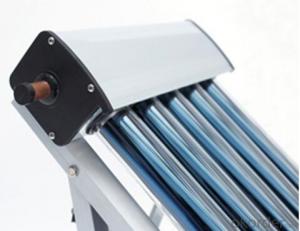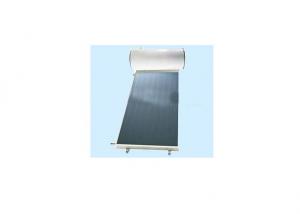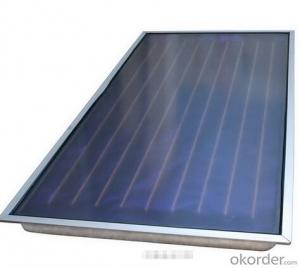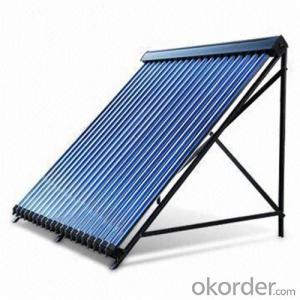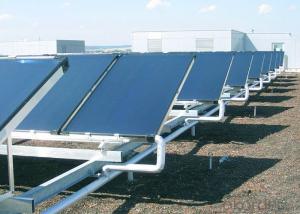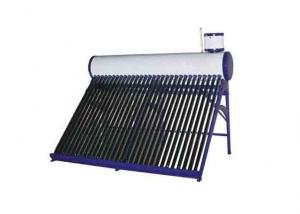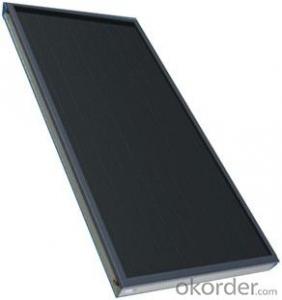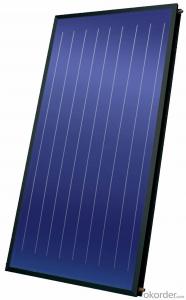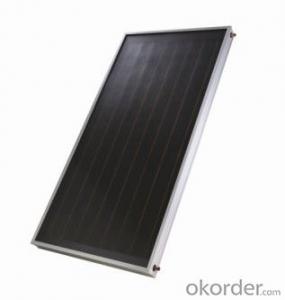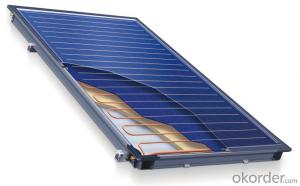Polyurethane Foaming Insulation Solar Collector Model SC-HP
- Loading Port:
- Shanghai
- Payment Terms:
- TT OR LC
- Min Order Qty:
- 50 set
- Supply Capability:
- 200 set/month
OKorder Service Pledge
OKorder Financial Service
You Might Also Like
1. Structure of Polyurethane Foaming Insulation Solar Collector Model SC-HP:
This product is composed of aluminium alloy for frame, polyurethane and aluminium silicate for the insulation,tri-element vacuum glass tube and antifreeze heat pipe. It can work under the environmental temperature from -40℃ to 95℃.The solar collector has the structure as follows:
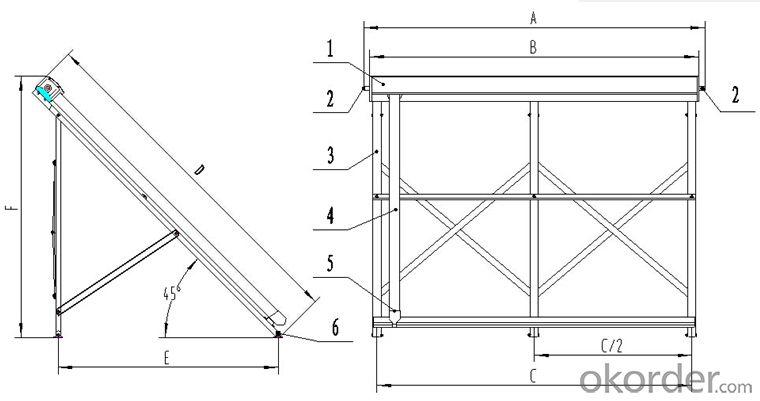
1,Solar collector manifold :
2,Solar collector connector
3,Solar collector bracket
4,All glass vacuum tube:
5,Tube holder
6,Wind feet
2. Main Features of Polyurethane Foaming Insulation Solar Collector Model SC-HP:
The heat insulation properties is higher than for other types of the same collector design
Three layers of insulation incorporated in the mainfold casing :
(1)first and third layer is Aluminium Silicate and resist temperatures of up to 800℃;
(2)second layer is Polyurethane formed by Italian machine that insulates the tanks with a density of 38.5-42;
3. Polyurethane Foaming Insulation Solar Collector Model SC-HP Images:
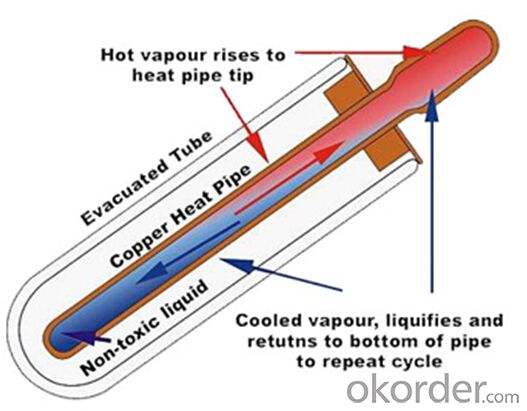
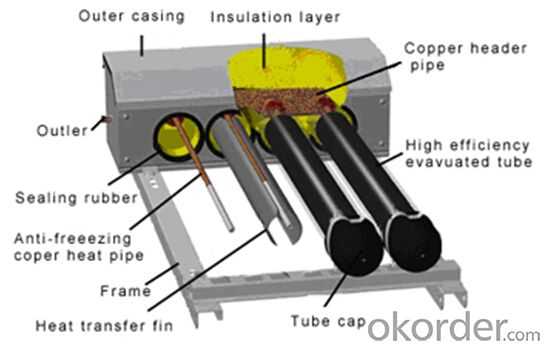
4. Polyurethane Foaming Insulation Solar Collector Model SC-HP Specifications
Model | SC-HP-10 | SC-HP-15 | SC-HP-18 | SC-HP-20 | SC-HP-24 | SC-HP-25 | SC-HP-30 |
SC-H1-10 | SC-H1-15 | SC-H1-18 | SC-H1-20 | SC-H1-24 | SC-H1-25 | SC-H1-30 | |
Vacuum tube quantity(pcs) | 10 | 15 | 18 | 20 | 24 | 25 | 30 |
Tube spacing (㎜) | 75 | 75 | 75 | 75 | 75 | 75 | 75 |
Vacuum tube diameter/length (㎜) | φ58/1700 | φ58/1700 | φ58/1700 | φ58/1700 | φ58/1700 | φ58/1700 | φ58/1700 |
Vacuum tube material | high borosilicate glass 3.3 | high borosilicate glass 3.3 | high borosilicate glass 3.3 | high borosilicate glass 3.3 | high borosilicate glass 3.3 | high borosilicate glass 3.3 | high borosilicate glass 3.3 |
Vacuum tube inner/outer pipe wall thickness (㎜) | 1.6/1.8 | 1.6/1.8 | 1.6/1.8 | 1.6/1.8 | 1.6/1.8 | 1.6/1.8 | 1.6/1.8 |
Heat pipe condensing end diameter/length (㎜) | φ14/1750 | φ14/1750 | φ14/1750 | φ14/1750 | φ14/1750 | φ14/1750 | φ14/1750 |
heat pipe material/wall thickness (㎜) | Copper tp2/0.6 | Copper tp2/0.6 | Copper tp2/0.6 | Copper tp2/0.6 | Copper tp2/0.6 | Copper tp2/0.6 | Copper tp2/0.6 |
inner tank diameter/wall thickness (㎜) | φ35/1.0 | φ35/1.0 | φ35/1.0 | φ35/1.0 | φ35/1.0 | φ35/1.0 | φ35/1.0 |
connector size | φ22 or 3/4″ | φ22or 3/4″ | φ22or 3/4″ | φ22or 3/4″ | φ22or 3/4″ | φ22or 3/4″ | φ22or 3/4″ |
collector insulation material/thickness (㎜) | Polyurethane/40 | Polyurethane/40 | Polyurethane/40 | Polyurethane40 | Polyurethane40 | Polyurethane/40 | Polyurethane/40 |
solar collector rated pressure (MPa) | 0.6 | 0.6 | 0.6 | 0.6 | 0.6 | 0.6 | 0.6 |
collector operating temperature ℃ | <100 | <100 | <100 | <100 | <100 | <100 | <100 |
collector volume (L) | 0.69 | 0.98 | 1.15 | 1.27 | 1.50 | 1.56 | 1.85 |
collector aperture area (㎡) | 1.0 | 1.5 | 1.8 | 2.0 | 2.4 | 2.5 | 3.0 |
collector total area (㎡) | 1.56 | 2.30 | 2.74 | 3.04 | 3.63 | 3.77 | 4.51 |
referral traffic (L/min) | 0.75 | 1.13 | 1.35 | 1.50 | 1.81 | 1.88 | 2.26 |
intensity pressure (Pa) | 23.2 | 59.2 | 90.6 | 116.7 | 181.7 | 200.2 | 314.0 |
intercept efficient η0 | 0.744 | 0.744 | 0.744 | 0.744 | 0.744 | 0.744 | 0.744 |
heat loss coefficient a | 2.09 | 2.09 | 2.09 | 2.09 | 2.09 | 2.09 | 2.09 |
collector power (W)1000W/㎡ irradiation | 620 | 870 | 1047 | 1165 | 1401 | 1457 | 1748 |
collector net weight (kg) | 38.25 | 50.75 | 59.75 | 64.75 | 79.00 | 83.35 | 98.70 |
a (㎜) | 895 | 1270 | 1495 | 1645 | 1945 | 2020 | 1395 |
b (㎜) | 800 | 1175 | 1400 | 1550 | 1850 | 1925 | 2300 |
c (㎜) | 725 | 1100 | 1325 | 1475 | 1775 | 1850 | 2225 |
c/2 (㎜) | —— | —— | —— | —— | 887.5 | 925 | 1112.5 |
d (㎜) | 1980 | 1980 | 1980 | 1980 | 1980 | 1980 | 1980 |
e (㎜) | 1240 | 1240 | 1240 | 1240 | 1240 | 1240 | 1240 |
f (㎜) | 1470 | 1470 | 1470 | 1470 | 1470 | 1470 | 1470 |
5. FAQ
(1) Which collector is the best value for money?
Rather than looking at just peak efficiency levels when comparing solar collectors, cost per unit of energy produced is much more logical. For example: Although collector A may be 20% more efficient than collector B, if collector A is 30% more expensive, then in fact collector B may be a better choice, as per kWh of energy produced per day it is cheaper. When payback time is of concern, not only price per kWh of the product is important, but also of the end system.
(2) Can this solar collectors be used for a large scale hot water production?
Yes. This solar collectors can be connected in series or parallel to provide large scale hot water production for a commercial settings such as a school, hotel or office building. There is really no limit to the size of the system, however collectors must be installed in banks of no more than 150 tubes (in series), otherwise the water may boil.
(3) What maintenance of the solar collector is required?
Under normal circumstances no maintenance of the system is required. Due to the shape of the tubes regular rainfall and wind should keep the tubes clean. Should a tube even be broken it should be replaced. This, however, is an inexpensive and easy job. Any "handy" person can install a new tube (while adhering to local health and safety regulations). Sidite solar collectors can operate with several broken tubes, however the efficiency will be reduced slightly.
- Q:How do solar collectors compare to geothermal heating systems in terms of efficiency?
- Solar collectors and geothermal heating systems are both highly efficient methods of harnessing renewable energy for heating purposes. However, their efficiency can vary depending on various factors. Solar collectors, also known as solar thermal systems, work by capturing the sun's energy and converting it into heat. They are typically installed on rooftops or open areas where they can receive direct sunlight. The efficiency of solar collectors is influenced by factors such as the angle and orientation of the panels, the amount of sunlight available, and the efficiency of the system's components. On the other hand, geothermal heating systems utilize the constant temperature of the earth to provide heating. These systems extract heat from the ground through a network of pipes buried underground, which is then used to heat homes or water. Geothermal heating systems generally have a higher efficiency compared to solar collectors because the earth's temperature remains relatively constant throughout the year. This stability allows geothermal systems to consistently provide heat efficiently, regardless of weather conditions. In terms of overall efficiency, geothermal heating systems have an advantage over solar collectors. Geothermal systems typically have a coefficient of performance (COP) of around 3 to 5, meaning they can produce three to five units of heat energy for every unit of electrical energy consumed. In contrast, solar collectors have a lower COP, usually ranging from 1 to 2.5. This means that for every unit of electrical energy used to power the solar collector, it can produce one to two and a half units of heat energy. However, it is important to note that the efficiency of both solar collectors and geothermal heating systems can be influenced by factors such as system design, installation quality, and maintenance. Additionally, the availability and cost-effectiveness of these systems may vary depending on geographical location and local climate conditions. Ultimately, while geothermal heating systems generally have a higher efficiency compared to solar collectors, the suitability of each system depends on various factors such as location, local climate, and individual requirements. It is recommended to consult with a professional to determine the most efficient and suitable renewable heating option for a specific situation.
- Q:Can solar collectors be used for generating electricity on public transportation systems?
- Yes, solar collectors can be used for generating electricity on public transportation systems. By installing solar panels on the roofs or exteriors of buses, trams, or trains, the energy from the sun can be harnessed and converted into electricity to power various systems on board, such as lighting, air conditioning, or even propulsion. This provides a sustainable and clean energy source, reducing reliance on fossil fuels and decreasing the environmental impact of public transportation.
- Q:How are solar collectors different from solar panels?
- Solar collectors and solar panels are both used to harness the energy from the sun, but they differ in their purpose and functionality. Solar collectors are specifically designed to capture and convert thermal energy from the sun into heat. These collectors are typically used for heating water or air in residential, commercial, or industrial applications. They consist of a series of tubes or pipes that circulate a heat transfer fluid, such as water or antifreeze, which absorbs the heat from the sun and transfers it to a storage tank or directly to the desired application. Solar collectors are most commonly used in solar water heating systems or for space heating. On the other hand, solar panels, also known as photovoltaic (PV) panels, are used to convert sunlight directly into electricity. They consist of multiple solar cells made of semiconductor materials, such as silicon, which generate electricity when exposed to sunlight. Solar panels are primarily used for generating electricity in residential, commercial, and utility-scale solar power systems. They can be mounted on rooftops, integrated into building materials, or installed as ground-mounted arrays. In summary, solar collectors are designed to capture and convert solar energy into heat, while solar panels are used to directly convert sunlight into electricity. Both technologies play important roles in harnessing solar energy and are utilized in various applications to reduce dependence on traditional sources of energy and promote sustainability.
- Q:Are solar collectors suitable for use in remote areas?
- Yes, solar collectors are highly suitable for use in remote areas. They do not require extensive infrastructure or connection to the electric grid, making them a cost-effective and efficient solution for generating clean energy in isolated locations. Additionally, solar collectors can withstand harsh weather conditions and can be easily transported and installed, making them ideal for remote areas with limited access to traditional energy sources.
- Q:Can solar collectors be used for heating in coastal areas?
- Solar collectors are capable of being utilized for heating purposes in coastal areas. The primary benefit of solar collectors lies in their ability to harness the sun's energy for heating water or air, irrespective of the location. Coastal areas specifically receive an abundance of sunlight, which renders them highly suitable for solar energy applications. Furthermore, coastal areas typically experience lower temperatures in comparison to inland regions, thereby emphasizing the necessity for heating. Solar collectors can be employed to warm water for various domestic activities such as showering, dishwashing, and laundry. They can also cater to the heating requirements of residential or commercial buildings. Moreover, solar collectors can be utilized to heat swimming pools and other recreational water facilities. By implementing solar collectors in coastal areas, not only is an efficient and renewable energy source provided, but also a reduction in reliance on fossil fuels is achieved. Consequently, this contributes to a more sustainable and environmentally friendly solution for heating needs.
- Q:Are solar collectors suitable for heating livestock barns?
- Yes, solar collectors are suitable for heating livestock barns. Solar collectors, such as solar water heaters or solar air heaters, can provide a sustainable and cost-effective solution for heating livestock barns. They utilize the sun's energy to generate heat, which can be used to warm up the barns during colder months. This can help maintain a comfortable temperature and create a healthier environment for the livestock, promoting their well-being and productivity. Additionally, solar collectors have low maintenance requirements and can be easily integrated into existing barn structures. Overall, using solar collectors for heating livestock barns can reduce energy costs, decrease reliance on fossil fuels, and contribute to a more sustainable agricultural system.
- Q:Can solar collectors be used for heating sewage treatment plants?
- Yes, solar collectors can be used for heating sewage treatment plants. Solar thermal systems can provide a sustainable and cost-effective solution to heat the water used in sewage treatment processes. By harnessing solar energy, these collectors can help reduce the reliance on traditional heating methods, thereby saving energy and reducing greenhouse gas emissions.
- Q:What are the different types of solar collectors?
- There are three main types of solar collectors: flat plate collectors, evacuated tube collectors, and concentrating collectors.
- Q:How much energy can a solar collector produce?
- The amount of energy a solar collector can produce varies depending on several factors such as the size and efficiency of the collector, the amount of sunlight available, and the location. On average, a solar collector can generate anywhere from 100 to 400 watts per square meter of collector area. However, with advancements in technology and larger installations, it is possible to achieve even higher energy production.
- Q:Can solar collectors be used in areas with limited access to financing options?
- Yes, solar collectors can be used in areas with limited access to financing options. There are various financing models available that can make solar energy affordable, such as leasing, power purchase agreements, and community solar programs. Additionally, governments and non-profit organizations often provide grants and subsidies to support the adoption of solar energy in underserved areas, further increasing accessibility.
1. Manufacturer Overview |
|
|---|---|
| Location | |
| Year Established | |
| Annual Output Value | |
| Main Markets | |
| Company Certifications | |
2. Manufacturer Certificates |
|
|---|---|
| a) Certification Name | |
| Range | |
| Reference | |
| Validity Period | |
3. Manufacturer Capability |
|
|---|---|
| a)Trade Capacity | |
| Nearest Port | |
| Export Percentage | |
| No.of Employees in Trade Department | |
| Language Spoken: | |
| b)Factory Information | |
| Factory Size: | |
| No. of Production Lines | |
| Contract Manufacturing | |
| Product Price Range | |
Send your message to us
Polyurethane Foaming Insulation Solar Collector Model SC-HP
- Loading Port:
- Shanghai
- Payment Terms:
- TT OR LC
- Min Order Qty:
- 50 set
- Supply Capability:
- 200 set/month
OKorder Service Pledge
OKorder Financial Service
Similar products
New products
Hot products
Hot Searches
Related keywords
